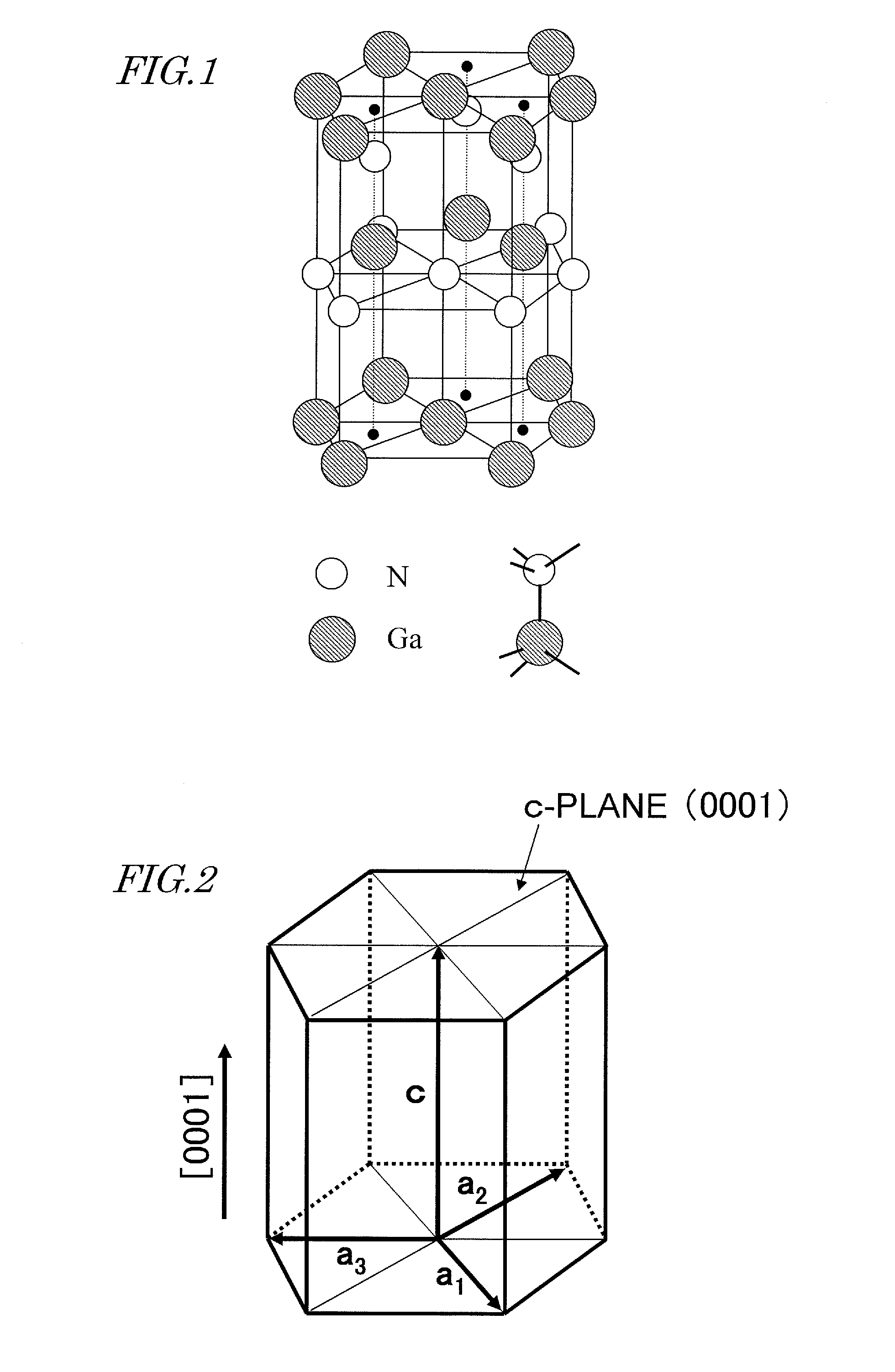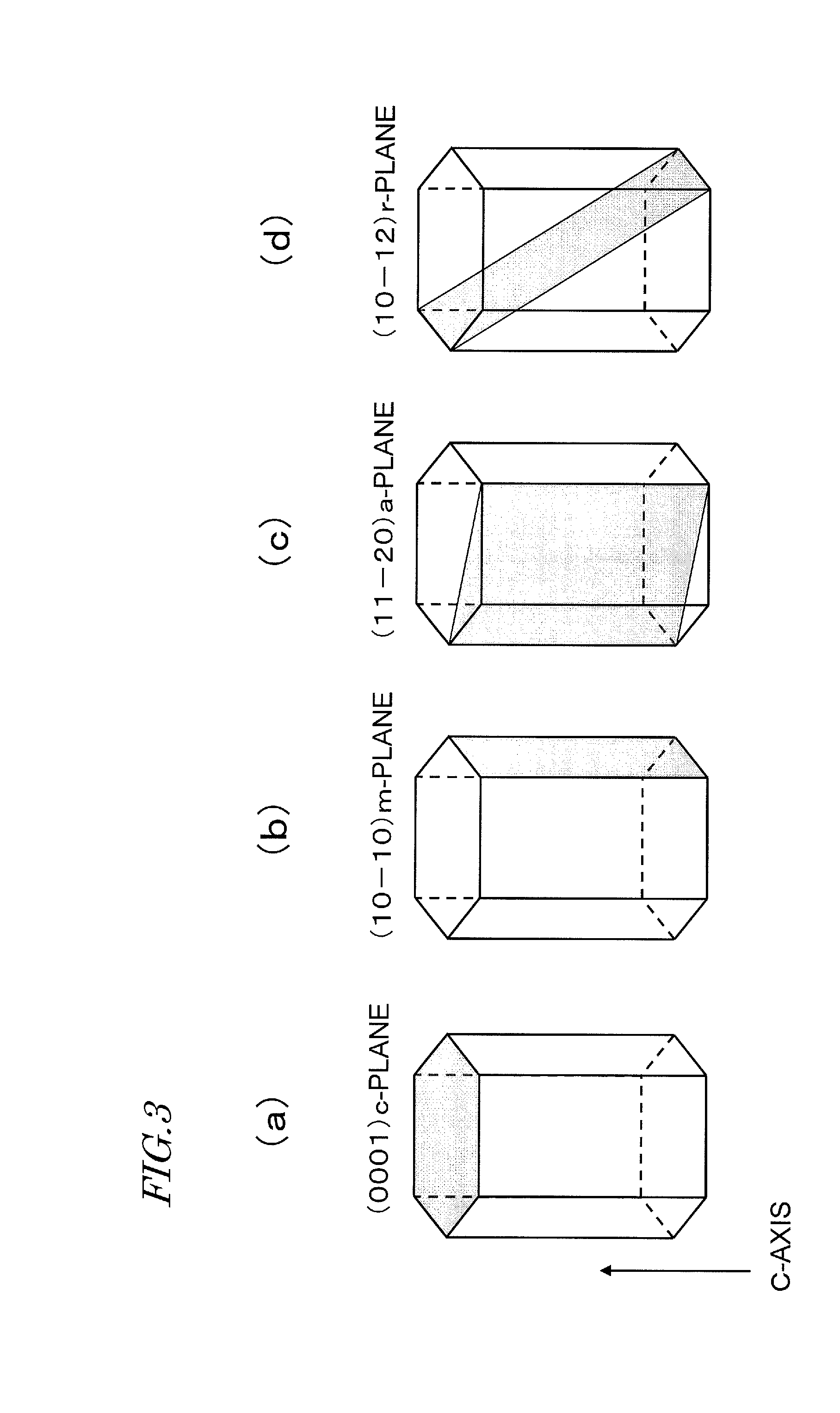Method for manufacturing nitride semiconductor element
a gallium nitride and compound semiconductor technology, applied in semiconductor/solid-state device testing/measurement, instruments, semiconductor lasers, etc., can solve the problems of reducing the probability of radiative recombination, increasing power consumption, and reducing the internal quantum yield, so as to achieve high emission efficiency
- Summary
- Abstract
- Description
- Claims
- Application Information
AI Technical Summary
Benefits of technology
Problems solved by technology
Method used
Image
Examples
embodiment 1
[0086]FIG. 7 is a graph showing a characteristic curve for formation of an m-plane In0.1Ga0.9N well layer 14 whose emission wavelength is about 410 nm±5 nm.
[0087]This characteristic curve (a line connecting five solid triangles (▴)) represents the relationship between the In supply mole fraction and the growth temperature which was obtained under the conditions that the pressure was 300 Torr and the growth rate was about 6.0 nm / min. The intended emission wavelength is about 410 nm±5 nm. For the respective values of the In supply mole fraction, 0.30, 0.40, 0.50, 0.60, and 0.83, the values of the growth temperature required for obtaining an In0.1Ga0.9N well layer 14 which achieves the emission wavelength of about 410 nm±5 nm are indicated by solid triangles (▴) in FIG. 7.
[0088]In the graph of FIG. 7, the ordinate axis on the right side represents the PL emission intensity (□) obtained by performing photoluminescence (PL) measurement on samples of the light-emitting device 10 which wer...
embodiment 2
[0096]FIG. 9 shows the relationship between the In supply mole fraction and the growth temperature which was obtained under the condition that the growth rate was about 12.0 nm / min. The intended emission wavelength is about 410 nm±5 nm, which is equal to the value of Embodiment 1. For the respective values of the In supply mole fraction, 0.50, 0.60, 0.65, and 0.70, the values of the growth temperature required for obtaining an m-plane In0.1Ga0.9N well layer 14 which achieves the emission wavelength of about 410 nm±5 nm are indicated by solid triangles (▴) in FIG. 9. The values of the PL emission intensity of the well layers of the In0.1Ga0.9N well layers 14 which were formed with the values of the In supply mole fraction and the growth temperature indicated by the solid triangles (▴) are indicated by open boxes (□) in the graph of FIG. 9.
[0097]The values of the data of points ▴ and □ of FIG. 9 are shown in Table 2.
TABLE 2Growth temperature760° C.770° C.770° C.770° C.In supply mole f...
embodiment 3
[0100]FIG. 10 shows the relationship between the In supply mole fraction and the growth temperature which was obtained under the conditions that the pressure was 500 Torr and the growth rate was about 12.0 nm / min. The intended emission wavelength is about 410 nm±5 nm, which is equal to the values of Embodiments 1 and 2. For the respective values of the In supply mole fraction, 0.25, 0.30, 0.40, and 0.60, the values of the growth temperature required for obtaining an m-plane In0.1Ga0.9N well layer 14 which achieves the emission wavelength of about 410 nm±5 nm are indicated by solid triangles (▴) in FIG. 10. The values of the PL emission intensity of the well layers of the In0.1Ga0.9N well layers 14 which were formed with the values of the In supply mole fraction and the growth temperature indicated by the solid triangles (▴) are indicated by open boxes (□) in the graph of FIG. 10.
[0101]The data of points ▴ and □ in FIG. 10 are shown in Table 3.
TABLE 3Growth temperature750° C.770° C.7...
PUM
 Login to View More
Login to View More Abstract
Description
Claims
Application Information
 Login to View More
Login to View More - R&D
- Intellectual Property
- Life Sciences
- Materials
- Tech Scout
- Unparalleled Data Quality
- Higher Quality Content
- 60% Fewer Hallucinations
Browse by: Latest US Patents, China's latest patents, Technical Efficacy Thesaurus, Application Domain, Technology Topic, Popular Technical Reports.
© 2025 PatSnap. All rights reserved.Legal|Privacy policy|Modern Slavery Act Transparency Statement|Sitemap|About US| Contact US: help@patsnap.com



